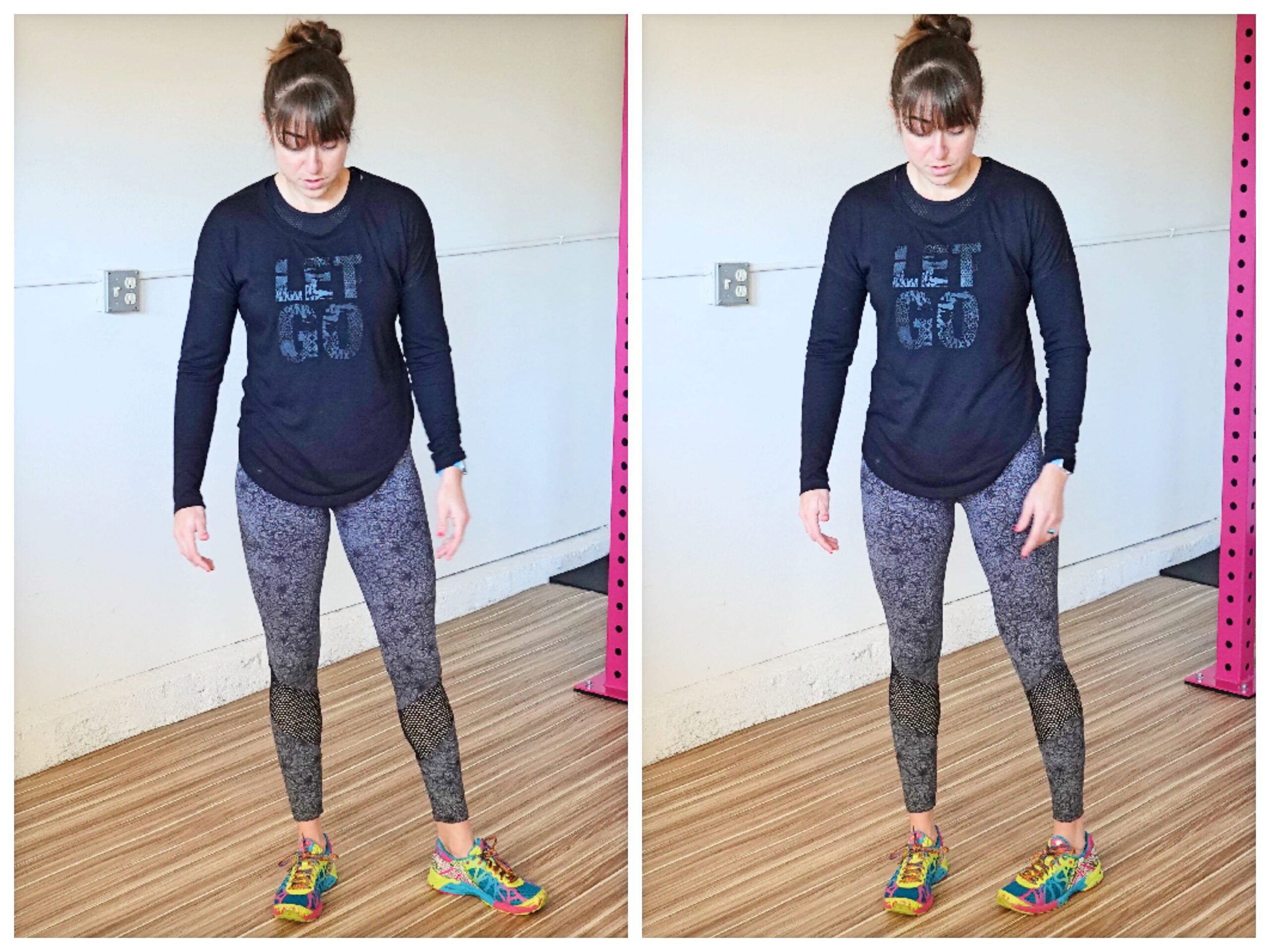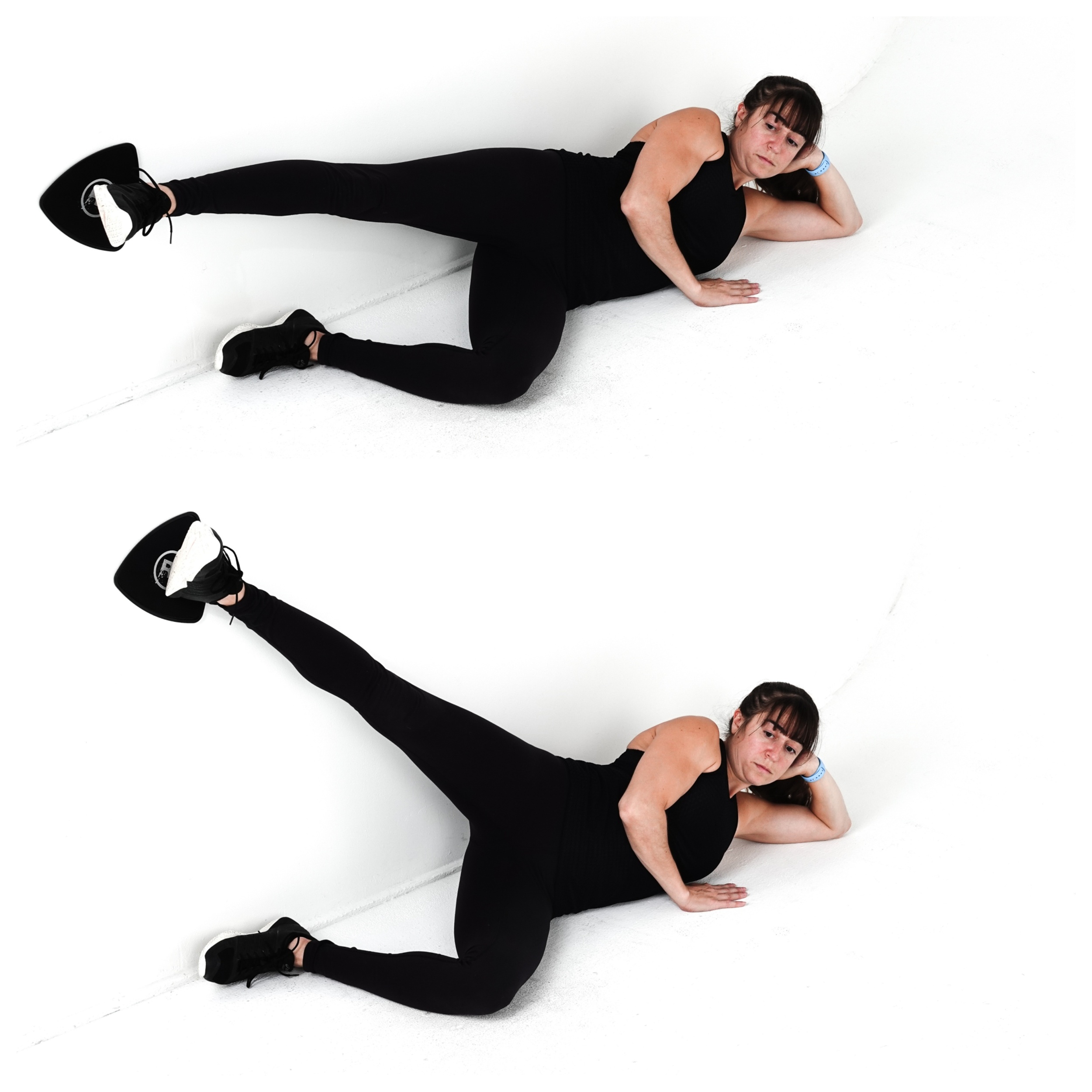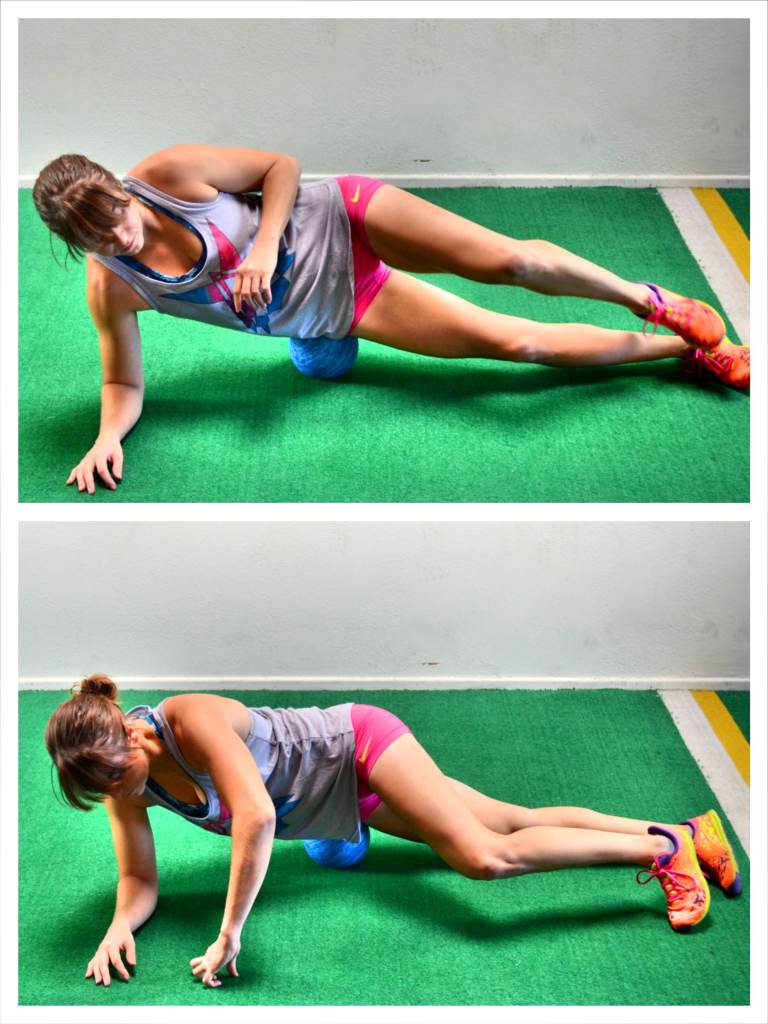The psoas has become the sexy hip flexor muscle to talk about and work on.
But what if I told you that all too often the TRUE culprit of our back, hip, IT BAND, knee pain and even ANKLE pain had to do with ANOTHER hip flexor muscle?!
What if I told you that you should actually be paying attention to your TFL or your Tensor Fasciae Latae.

The TFL can be a nasty little sucker, compensating for a week glute medius, perpetuating IT Band tightness and impacting everything down to our feet and ankles.
It contributes to internal hip rotation AND external tibial rotation.
Because of its far reaching impact it is a muscle we can’t ignore.
However, the hard part about addressing TFL tightness and overactivity is that many of the moves we need to do to CORRECT the issue, can often PERPETUATE IT!
For instance, to help prevent the TFL from continuing to compensate, we need to include glute medius strengthening.
But ever notice how you’ll do Monster Walks and feel the front side of your hip working?
Ever push through thinking “Oh yea! Feel that burn!?”
Or maybe you don’t even think about what is working. You’re doing the “right moves” so you just believe you SHOULD get results, right?
WRONG!
If you’re doing the right moves but still allowing muscles to compensate, not only are you NOT correcting the problem, but you may be making it worse.
So when you feel that front outside of your hip working during those mini band walks? Guess what is not working as it should and what is also COMPENSATING for that underactive muscle!?
Well your glute medius is not getting the benefit of the exercise it should be getting and instead you’re perpetuating the overuse of your TFL!
So all of that rehab? It isn’t going to pay off.
While you need to strengthen your glute medius, you need to realize that all too often our TFL can compensate for a weak glute medius.
Because this muscle then becomes even further overworked and even shortened, it can lead to lower back hip and knee pain, not to mention even IT Band issues and foot and ankle problems!
Yup! Through our IT Band the TFL can create movement compensations down our entire leg!
And when we then see changes to our ANKLE mobility guess what happens? Those changes only further perpetuate those compensations back UP our kinetic chain.
It’s why you can’t just IGNORE aches and pains. The longer you ignore them and keep pushing through, the more you then just allow compensations and imbalances to build up so there is more to have to sort through later.
If you don’t address TFL issues, you’ll end up having to address issues from your feet up!
So how can we prevent our TFL from leading to all of these aches and pains when it wants to work during the exercises we NEED to be doing to correct it?
Here are three tips to help you quiet down that TFL and get your glutes activated! And to then implement these tips, check out the quick series I’ve included at the end of this post!
As you go through implementing these tips, be CONSCIOUS of what you feel working. Don’t just rush through the moves! Be intentional with your prehab moves!
3 Tips To Strengthen Your Glutes And Prevent Your TFL From Compensating!
#1: Treat the TFL like a toddler. Keep it distracted so you can get work done!
Basically, you want to adjust movements to help make it EASIER to establish that mind-body connection.
One way to do that is to “keep the TFL busy” by internally rotate your foot during lateral raise, or abduction, movements.
Because the TFL performs hip internal rotation, you can almost “distract” it with that movement AS you use the glute medius to perform the lateral raise.
So if during lateral raises you notice you often feel the front of your hip, turn your toe down toward the ground.
You may even notice often that your toe is turned out toward the ceiling.
The TFL contributes to tibial external rotation.
So internally rotate your foot is the OPPOSITE action, which can help “shut off” the TFL. Not to mention when you internally rotate your tibia, you often then even internally rotate our hip by extension.

Maintaining this internal rotation, you can then perform your lateral raise movement.
If you still are struggling to feel your glute medius, you can even kick slightly back as you raise up OR put your hip into extension, driving back into a slider or wall AS you perform that lateral raise movement.
This hip extension and slight kick back will engage your glute max, which will also hinder the TFL from taking over and allow you to potentially better activate your glute medius. This works because the TFL is a hip flexor so by putting your hip into extension, you can inhibit it from working!

#2: Change the hip flexion during those abduction moves.
When you’re first starting to “rehab” an issue, you need to use the moves you feel the most and build off of those.
Basically you want to take the path of least resistance to establish that mind-body connection.
If you feel a move working those glutes, use that first THEN even dive into other moves because you’ve already established that mind-body connection.
To find that move that helps you establish that mind-body connection, you may need to adjust the exact POSTURE you use during basic abduction moves.
By adjusting the amount of hip flexion or extension you perform the move in, you can find a way to maximize your glute medius engagement and minimize your TFL compensation.
It isn’t a clear cut and dry rule of what posture is best so you may want to play around to see what matches your personal recruitment patterns.
For some more flexion may “distract” the TFL because it is a hip flexor.
However, for some, more hip flexion may perpetuate it being overactive during those abduction moves.
In this case, putting the hip into more extension may be key to inhibit the muscle.
While you of course want the glute medius to be strong in both a slightly more hip-flexed or hip-extended state, you do want to start with the move you feel working correctly to make sure you establish that mind-body connection.
The fact that hip flexion can play a role in how much you’re able to engage the TFL is why that oh so “basic” clam exercise can so often backfire too!
The clam is a traditional glute activation movement. But this seemingly simple move is so often butchered. First off, you may find you need to use that internal rotation of the tibia I mentioned in the first tip to help.
Secondly, you may adjust how much you pull your knees forward or straighten your legs out.
The key is being conscious of what you feel working to then ADJUST your exact amount of hip flexion.
A great way to play around with different amount of hip flexion during even a bilateral abduction move is even seated on a bench.

You can lean back, sit up tall or even lean forward to different degrees to not only strengthen your glute medius in a variety of postures BUT also find the exact position that works best for you.
We have to remember to focus on what we feel working so we can work around our own biomechanics.
#3: Foam roll and stretch BEFORE you activate.
If you struggle to activate a muscle, you may find that foam rolling and stretching the muscle prior to doing activation moves is oh so key!
While people debate the benefit of both techniques, with one of the main arguments against them being that the benefits are short-lived, that doesn’t mean you can’t use these “short-lived” benefits to your advantage.
By rolling your TFL and then stretching to improve your hip mobility, you can inhibit this overactive muscle, even if just temporarily.

If you interrupt that mind-body connection between your TFL and brain, and restore muscles to their proper length-tension relationships, you can then help yourself better establish the mind-body connection to the muscle you DO want to work – your glute medius!
So if you find your TFL is being a pesky little sucker and compensating for your glute medius no matter what posture or tweaks you do, try relaxing and inhibiting it IMMEDIATELY PRIOR to doing the glute activation moves.
Interrupt that communication so you can establish a new connection to those glutes!
A lacrosse ball is a great way to relax that TFL and even a simple half kneeling hip stretch with reach can improve your hip extension.
BONUS: If you have an imbalance do imbalanced prehab!
The one other key thing to note is if you have an imbalance, you need to do imbalanced rehab.
So if one side is constantly tight, you need to address that one side specifically.
You also want to assess if it is glute weakness on that SAME side or if there is even weakness on the OTHER side perpetuating the issues and leading to the TFL becomign overworked!
Of course seeing someone to asses you is key but KNOWLEDGE IS POWER. So now you can be aware of what you’re doing in your workouts and therefore why you are, or aren’t, seeing the results you want to seek out the help you need.
Using these tweaks you can help yourself strengthen your glutes and prevent your TFL from constantly compensating!
Now try implementing them in this amazing series below!
Quick Hip Mobility Series To Prevent IT Band Issues, Back, Hip And Knee Pain!
This Avoid IT Band Issues Series uses foam rolling and stretching to address your TFL tightness and overactivity. It even works to relax your peroneal (the outside of your lower leg) to make sure you’re working on any issues from the ground up.
It then uses two great abduction moves to activate your glute medius!
The Avoid IT Band Issues Series
Complete 1 round through the circuit below, spending a minute per move on each side.
CIRCUIT:
1 minute per side Peroneal Foam Rolling
1 minute per side TFL Foam Rolling
1 minute Standing TFL Stretch
1 minute per side Lying QL Stretch
1 minute Bridge Abductions
1 minute per side Lying Side Raises
Need more amazing series to improve your hip mobility and prevent lower back, hip and knee pain?
Join my 28-Day Booty Burner program!





Often times when I do hip lifts, My hamstrings cramp up on the lower part of my hamstring. What am I doing wrong and how can I better activate my gluteus? Thanks!
Sorry which move? Are you foam rolling prior?
Thank you Cori, I’m experiencing this from years of running over 40 years of marathon running. I’m going to apply these and hope for progress, this year I’ve cut down long distances & hope to reduce further no more than 13 miles longest
Thanks Buyi let me know how it goes!
Cori, You are so knowledgeable!! I am 46 and after so many years of heading down rabbit holes on youtube I would occasionally keep landing on your content. After reading this post, and YES, years of wasted monster walks, side lying leg lifts, and clams with a STILL a tight TFL, I finally said to myself STAY HERE and listen to this woman you dummy. I cannot wait to implement these ideas.
I’ve paid heaps of $$$ to try and get my lower back issues fixed no one has ever suggested tight TFL or rehab to help in this area I’m on day 2 of following your instructions and I have no pain so thank you your work and knowledge is amazing
So glad it’s helped Hohi!
This exercise is amazing. Thank You.
Glad the article helps!
I’ve had to take a break from running due to TfL pain & last week had cortisone into it. Not sure it’s helped much.
I’ll try & work this out, see if can’t make a difference with your advice. I thought I was strengthening my glutes but maybe I’m not!
Hi Cori,
I have a glute medius tear, a hip labral tear and hamstring tedinosis. I signed up for your Rstoration and booty burner programs. I have rested from the gym for a year and have recently started working out again. My hamstring and knee hurts all for no reason at all, which mobility exercise should I do to help alleviate the pain and correct imbalances? What can I do to fully heal both tears? How can I know if my hamstring is over stretched?
Thanks.
Sometimes it’s little tweaks to moves that add up. So often we are doing the right moves with improper recruitment patterns which keeps us stuck!
Have you gone to physio Vanessa over that year? And your hamstring and hip don’t hurt for no reason at all…it’s all connected and those issues at your hip have led to overload and injury. I would recommend seeing someone if you haven’t to make sure you slowly rebuild. And as you do the RStoration hip and spine or knee series would be a great way to transition back into training.
How do I subscribe?
What are you trying to subscribe to?
Hi Cori, I am 59yo.
Have been suffering with one side knee pain for long time. I do foam roller but the pain always come back.
My question for you is how to find out which side should I work with mini band and abduction exercises more to compensate for this imbalance. I didn’t understand. Thank you very much.
Hi Angelina. A movement assessment is helpful to determine your exact imbalances and compensations. But you may need to activate the same side you roll. Your TFL may be compensating for your glute medius on that same side.
Oh my goodness Cori, just wanted to say thank you. I am happy I found a GOOD coach on Facebook. You do not know who I am (and it’s fine) but I have been in this industry since 1989 ( Let’s say that i have been fairly successful and I have seen my fair share of bullshit information over the years). You have made a very, very good video ( i would even risk saying the best I have seen in the last 15 years for sure) on TFL Gluteus Medius relation to low back pain. You gave me hope that it is still possible to find good valuable information in this social media… world I guess. You took something that can be very complex and made it as simple as possible and keeping it very educative. Thank you for sharing your accurate knowledge. Keep doing a great job.
Thank you Andre! I’m flattered and honored!
Hi Cori my TFL on my right side is
always tighter then my left due to using my right side more.Should I just be strenghing my left?
Depends on if the right is compensating for the right glute medius or the right side is overworked from your left…
What is TFL
It’s a hip flexor muscle. 🙂
Hi just wondering…do you have home programs or personal training programs available for this? I’ve been dealing with IT band issues (self inflicted unfortunately through therapy) and really want to try this out!
Hi Brooke. Yes I do 🙂 If you want to email me at [email protected], I’m happy to chat options!
Is there a printable version please?
Thank you.
If you right click, there is usually an option to print 🙂
Hi Cori,
It is easier to read the article, than to comprehend all via Youtube 🙂 . But I got confused on the tibial rotation. First you say that: “It (the TFL) contributes to internal hip rotation and EXTERNAL tibial rotation.” , then “Not to mention when you INTERNALLY rotate your tibia, you often then even internally rotate our hip by extension.” Would you clarify this rotation: How can hip rotate internally, but the tibia to rotate externally? Aren’t they rotating together? I am running sometimes long distances, but after 4-5 hrs, my left ITB starts aching, the right one follows a bit later. Most likely I hv lazy glutes and TFL and hamstrings taking the job. Tks for your good channel and information!
Because of the TFL’s impact on the IT Band, you will see that impact then on the lower leg. So if you look at the movement pattern that occurs when the hips internally rotate, you’ll see knee valgus and the feet flatten and turn out. That’s how you get both hip internal but tibial external rotation. If you think about that knee collapse in movement as people squat or watch it in the videos when I try to demo that may explain it 🙂 The reason I say the internal rotation here of the lower leg is because it is the opposite of the tibial external rotation which inhibits it. And it often prevents you then from rotating open as you lift (which can then help avoid piriformis compensation as well). Plus it oddly keeps the TFL “busy” so you can focus on the glute medius as the prime mover during the lateral raise. Hope that clarifies!
Could a tight TFL restrict a deep squat? I used to be able to go deeper with ease, but now I feel like I get to 90 and almost hit a block!
Tight hip flexors can, yes. But so can ankle mobility, a lack of glute activation or even core stability.
Why do you start with the peronial rolling, and how does this tie into TFL tightening? I have the feet flattening and turnout that you describe as well as knee collapsing in.
I’ve been an on again off again runner for years and usually get slowed down/stopped by knee pain or peronial tendon pain.
Definitely check out the first video as I go over how the TFL can impact even tibial rotation. Because of this change in your lower leg positioning, the peroneal can also become tight. OR even tightness starting there can then impact your TFL so it is key you relax both.
Wow! Just doing this series my hip (which has been bothering me for days) feels open and pain free. Thank you! Is this something you recommend doing every day?
So glad it helped Bonnie! So I do recommend this series weekly and mobility work daily often to start, but I wouldn’t necessarily just do this every day.
Thanks! I’d been rolling the tfl and doing the QL stretch for a while now (I was familiar with those before I read this article) but I think rolling the peroneal in addition and adding the standing tfl stretch made a big difference for some reason. Maybe changing my foot position too. So thanks for those additions. I also just started doing some strengthening specific to the sartorious muscle. Mine is pretty tight on one side and I think is contributing to my hip pain. Your videos and these articles are really great. I appreciate the exercise science and anatomy information that you provide. I need to know what is happening and why. It makes such a difference.
Often it’s the systems together. Rolling is great BUT when you combine it with the stretching and activation as a series, the changes add up. And it’s those little tweaks sometimes we need to change that mind-body connection. Glad everything is helping you make those adjustments!
Thank you for a great and informative video!!! This will help me tremendously.
So glad it helps!
Can this lead to horrific planter fasciitis? I’ve got great big toes flexion so it’s not the usual planter fasciitis. I do get right perinonals and around ankle joint.
Because of it’s impact on the lower leg it can change ankle mobility, which can lead to other issues. But are you sure you have PF? Doesn’t sound like it if it is the peroneal tendon that has issues…You may want to get checked out!
Hi Cori….thank you for the content. Wish you were here in Washington State so I could come see you!
I’m wondering what kind of practitioner is best to see about imbalances? I know I have them…been to PT several times and just not really addressing them. Even when I ask about them. They still always have me do the same things bilaterally. Any suggestions for me?
PT being personal trainer or physio? I have a great online program and work with clients through that to correct imbalances…just saying ;-P Little shameless plug and a link to schedule a call in case… https://redefiningstrength.com/private-coaching?sl=blogcomment
Hi Cory,
Thanks for your guidance on TFL . I have developed IT band issues ever since my TKR, for more than a yr now. I am doing most exercises that you have shown except the foam roller, which is very painful. What else can I do?
I bought this program a couple of years ago – but the activation code didn’t work so I haven’t been able to use it
Hi Angela. I’m not sure what code you mean as I don’t send activation codes, but you have lifetime access to all of my programs and if you ever need help getting into your program, you can email me at any time at [email protected] and I can look into any issues you are having 🙂
Hi Cori- I am a 57 year old female who has always worked out; but with Covid fell off the wagon train. I’ve always had tight hips and now my hip flexors are almost constantly sore despite my recent consistent stretches. I’m positive the correct muscles are not activating but not sore how to go about strengthening/stretching and what to stretch and strengthen! Thanks for your help!
Hope you’ve gotten checked out. And while the foam rolling is painful, the full prehab process works together as a system so each part is key together!
So the 3-part prehab process is key and how you go about activating really depends on exactly which muscles are tight and overactive and which are weak. I emailed you to chat more as this really is a discussion and getting checked out/assessed is key!
I’ve just stumbled across this after dealing with TFL issues for years. Where is the video that’s referenced in the comments? Thank you:)
There are two videos in this post you’re commenting on. One is at the top and one is after this – Quick Hip Mobility Series To Prevent IT Band Issues, Back, Hip And Knee Pain! – toward the bottom.